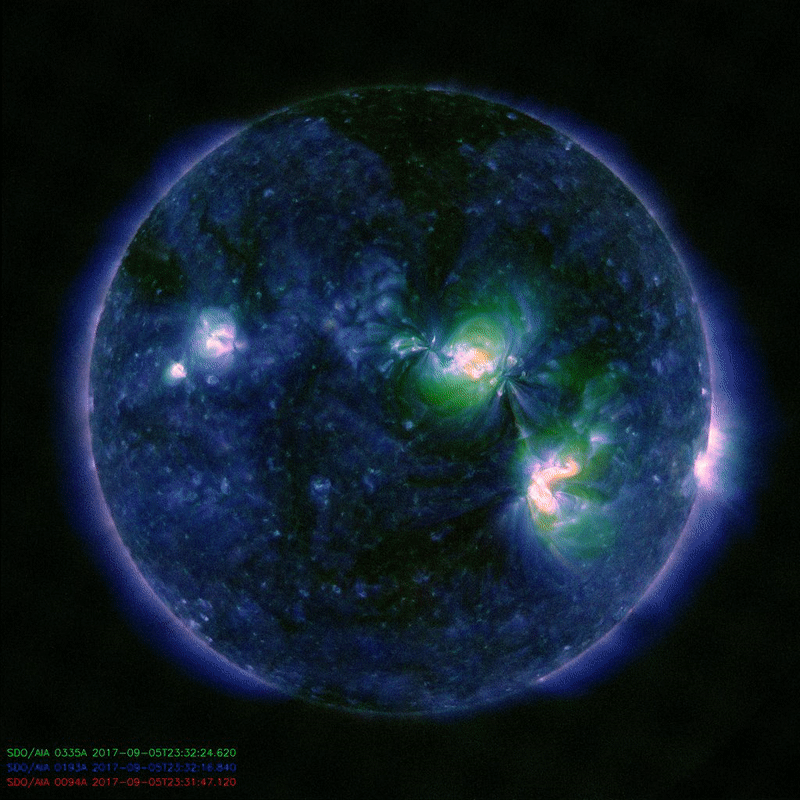Note: Following observations of the 2 August Transit of the moon across the sun, SDO failed to return to Science mode, hence the blank video composites below.
Daily, Dynamic Video Composite Loops of the Sun in the light of Extreme UltraViolet and soft X-Rays
High-Definition Movies of the Raging Sun 24/7
Be the first to spot solar flares as they erupt!
Six million degree gas from beneath the sun’s photosphere glows bright in the light of ionized Iron, ionized between 11 – 17 times! This gas is so hot, that between 11 to 17 electrons from a normal Iron atom have been stripped away!

Composite video of the sun as seen in the light of multiply-ionized iron at 94, 193 and 335 angstroms wavelength. Image credit: NASA/SDO (Solar Dynamics Observatory); video acquisition date, 6 September, 2017

Composite video of the sun as seen in the light of multiply-ionized iron at 171, 193 and 211 angstroms wavelength. Image credit: NASA/SDO (Solar Dynamics Observatory); video acquisition date, 6 September, 2017
Since both composites are dynamic and updated in real time simultaneously, side-by-side comparisons of the videos have the potential of providing insight into the sun’s internal structure and dynamism via outward temperature fluctuations.
The wavelengths represented in the videos range between 94 and 335 angstroms (9.4 – 33.5 nanometers). To get a sense of how these dimensions relate to our everyday experience, yellow-green light, the “color” our eyes are most sensitive to, is 5010 angstroms (501 nanometers) or about 100 times smaller than the width of a human hair.
All stars, including the sun, are dynamic, self-regulating systems, each powered by a huge nuclear fusion reactor in their cores. These cores of the sun and other stars in a similar evolutionary state currently produce helium and a tremendous amount of energy. From the 15 million-degree core plasma produced by these nuclear fusion reactors flows a stream of protons, electrons and helium nuclei, collectively referred to as the solar wind.
So why do these images and video appear mostly dark? Normally, we’re used to seeing the sun as a brilliant yellow-white disk. That’s because the sun’s “surface”, the photosphere has an effective temperature of 5,780 degrees Kelvin (9,945 F) and any object with that temperature will radiate most of its energy in the yellow-green part of the visible spectrum. This is why our eyes are most sensitive to that color range. The sun has no “surface”, just the boundary between the photosphere and the chromosphere, followed by the Corona, the sun’s outer, tenuous, million-degree atmosphere. The “dark” areas and regions of the sun in the video composites are much hotter than the paltry 5,800 Kelvin temperature of the photosphere, thus the “normal” photospheric temperature of 5,800 Kelvin is dark and cool compared to the six-million-degree gas. To radiate in the hard Ultraviolet or long X-ray bands of the spectrum, a gas has to be at least 200,000 Kelvin and, in the case of flares or outbursts from more interior regions of the sun, the temperature exceeds six million degrees. These are the regions we’re seeing; we’re looking “down into” the sun, especially in the case of a solar flare or “outburst”. The telescopes and cameras of the SDO are fitted with critically calibrated filters that are sensitive to these regions of the spectrum, regions only accessible from space.
For more data, information and content, please visit NASA’s Solar Dynamics Observatory.

